The Largest Fibroid
A 68 year old woman had been referred for treatment of a fibroid tumor. Due to the size she was unable to stand or walk, had dyspnea and dysuria.
A 68 year-old women, Para 2, was referred by a general practitioner to a private facility after more than 14 months of an inability to stand up, walk, dyspnea, and dysuria. She had been turned away from three provincial hospitals where she was told that she was too weak to undergo an operation for the removal of her large tumor.
Examination
1. She was clinically stable with mild pallor (Hb 8.4g/dl).
2. She was not able to stand on her own despite a power of 5/5 in the upper limbs.
3. She had an abdominopelvic tumor equivalent to 36 weeks pregnancy. It was woody hard, uniformly smooth, mobile side to side but no cranio-caudal mobility. (See images below)
4. Anaesthesiological evaluation found the patient to be fit for general anaesthesia. Four units of packed cells were ordered for intraoperative transfusion.
(Click to enlarge images)
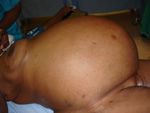
Incision and Surgery
A longitudinal midline suprapubic to xiphisternum incision was made. A relatively easy hysterectomy was preformed as the tumor was entirely extrapelvic into the abdominal cavity, owing to its size.
A huge fibroid with minimal flimsy omental and bowel adhesion was delivered from the abdominal cavity with help of an additional assistant.
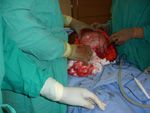
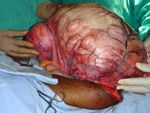
The abdominal wall was thinned and redundant but no attempt was made to reduce the size.
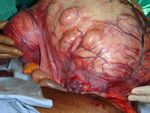
The fibroid had a weight of 13.2kg.
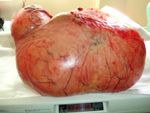
Post operative course
The patient reported vertigo, light headedness and a feeling that her body was too light for her legs to carry. She was mobilized over 2 days with a tripod by a physiotherapist. On the third day she was walking with a cane, and she was discharged with the cane on day four.
She had residual urine volume of 75ml. and was taught intermitted catheterization.
On review, 14 days post operatively, she could walk unaided without a cane. She had regained bladder tone with normal residual volume and had regained the tone of her anterior abdominal wall with minimal and cosmetically acceptable panniculum.
The patient is reported to be doing well in the rural South Africa, looking after her grandchildren and doing age-appropriate daily chores.
What was your biggest surgical challenge? Was it a large fibroid? Let us know in a comment.
S1E4: Dr. Kristina Adams-Waldorf: Pandemics, pathogens and perseverance
July 16th 2020This episode of Pap Talk by Contemporary OB/GYN features an interview with Dr. Kristina Adams-Waldorf, Professor in the Department of Obstetrics and Gynecology and Adjunct Professor in Global Health at the University of Washington (UW) School of Medicine in Seattle.
Listen
Study shows a healthy prenatal diet could be upstream obesity prevention strategy
December 26th 2024"Our findings support the recommendation of a healthy diet based on the current guidelines (as measured by the HEI) during pregnancy, since it may reduce patterns of infant growth outside reference ranges."
Read More
Early pregnancy cannabis use high in states with recreational legalization
November 11th 2024A population-based time-series analysis California before, during and after legalization show a rising trend in women using cannabis while pregnancy especially when the state has legalized the drug.
Read More
